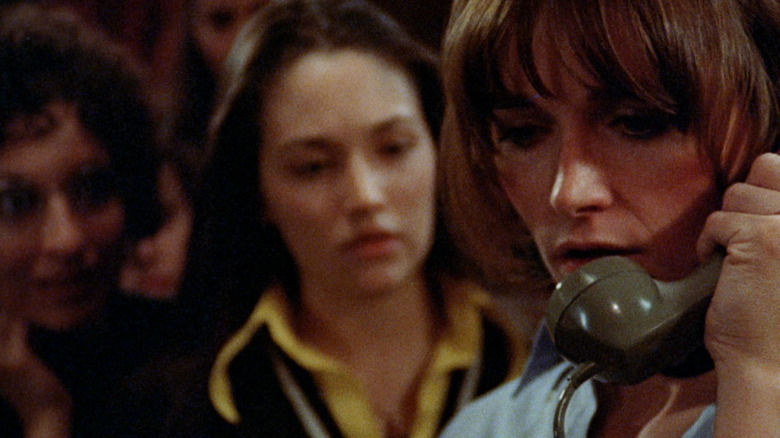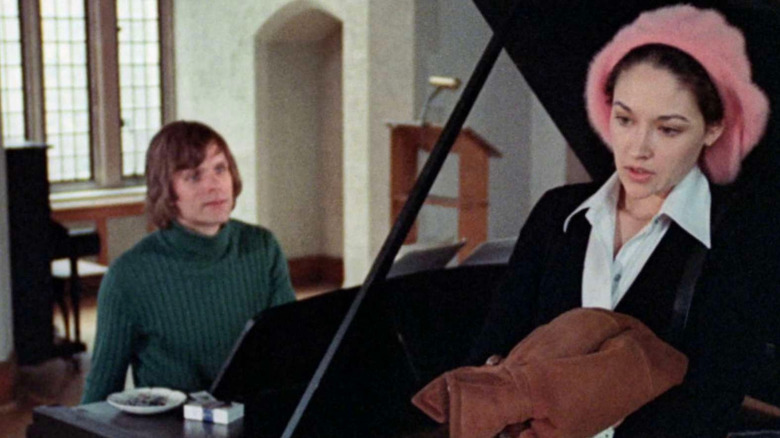Bob Clark Used 1974's Black Christmas To Redefine How Young Adults Were Portrayed On Film
It's 1974. Canada and the United States are challenging old ideas about women's bodily autonomy, a year removed from the Supreme Court's landmark Roe V. Wade decision legalizing abortion. Chaka Khan croons for her lover to "Tell Me Something Good" over the radio airwaves as Isabel Perón is sworn in as Argentina's first female president, weeks before Richard Nixon would resign from his presidential post amid the Watergate scandal. It's a time of shake-ups and seismic cultural shifts, reflected in the films people would flock to. Roman Polanski's "Chinatown" and Francis Ford Coppola's 'The Conversation" would tap into distrust of governments and institutions, and in horror, Tobe Hooper would disrupt the genre formula with his grim and influential screamfest "The Texas Chain Saw Massacre." Bob Clark's "Black Christmas" would be one of the first horror movies to center around a holiday both in title and plot, but the director had other shake-ups in mind when crafting his third feature.
The proto-slasher story was penned by Bob Moore with a rewrite by Timothy Bond, inspired by the old urban legend concerning a babysitter and a killer upstairs. The babysitter would be exchanged for a sorority house, tormented by an obscene caller/psycho killer, but these college students weren't the wide-eyed does of horror movies past. Led by a spirited Margot Kidder (whose boozy Barb gets the film's opening line, "Who left the god**** front door open?!") and a tenacious Olivia Hussey, these women are nonchalant about their sexuality and, on occasion, they curse and drink like sailors. Posters of nude couples and crude gestures adorn the building's walls, while house mother Mrs. MacHenry (Marian Waldman) hides booze in the bathroom toilet. Their crudeness, claims the director, was planned from the beginning.
Ho, ho, ho, ****
The beach party movies of the 1960s featured a different kind of college student. Despite plenty of suggestions of sex (the tagline for "Muscle Beach Party" teases, "When 10,000 biceps go around 5,000 bikinis, you know what's going to happen!"), their counterculture was still squeaky-clean. When the time came to tell his sorority-centered story, Clark was having none of that; an interview uploaded by FilmSchoolArchive contains the "A Christmas Story" director's insights:
"Certainly in 'Black Christmas,' I wanted to break some new ground. Step on was the attitude of the actors; I didn't want to do anymore 'Beach Blanket Bikini' movies which is what college and high school students had basically been treated [as]. I wanted them to be real college students, and they were. They were all pretty much that age, and we had Margot [Kidder] with her F-words, and Olivia ... all of them spoke and acted with the kind of sense and sensibility we would expect."
Jason Zinoman's comprehensive book "Shock Value" observes the "casual sexuality and coarseness" that characterizes the movie's sorority women, and how it's given weight beyond exploitation with the dynamic between Hussey's character, who becomes pregnant and chooses to have an abortion, and her walking red-flag boyfriend, who demands that she carry the child. Zinoman quotes Clark in a "Fangoria" interview:
"One of my main objectives was to show how sexual the girls are, how often they used the f-word, because people hadn't done it yet."
Indeed, one of the lasting superpowers of "Black Christmas," observes /Film's BJ Colangelo, is its depiction of "women who refuse to conform to the standards of polite, conservative society" and subsequently, how their safety is devalued. Horror audiences would see this template of hip young women again, but this time, John Carpenter would reshape it into a terrifying coming-of-age story.

